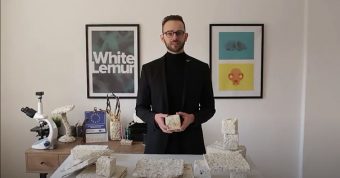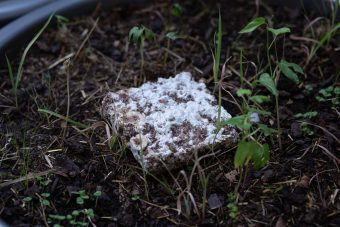
To the discovery of this material that riveted attention, the team of the White Lemur company has taken the back road. Before plunging themselves into innovations, they had been designing solutions for promotional products and packaging.
They realized there was a need for green materials, especially for those that can replace plastic and polystyrene in its many variants. Independently, at the same time, they had started another project of mushroom production that has pharmaceutical effects. Among the team who was developing a new product made from mushroom, was Nikola Stanojević, already experienced young man in the world of start-ups who graduated from the Biological Faculty in Belgrade.
He says that in that process of the IMUMIN supplement production they came upon a certain form of “waste” which, having been treated under specific conditions and in a particular way, can have identical performances as expanded polystyrene, e.g. Styrofoam. That result was the beginning of the SOMA project, developed in the White Lemur company, and the aim was to create technology for the production of that material, to check if some other material has similar qualities, as well as to find and test all possible uses and set up products made of this material.
In focus:
While Nikola was attending the Academy for the circular economy at the Serbian Chamber of Commerce, the instructor helped them analyze the matter stream and pollution source. Therefore, they realized that the use of Styrofoam, as a single-use packaging material, is one of the main sources of microplastics, due to the fact that Styrofoam is not degradable and recyclable.

It is either burnt that causes green gas emission or disposed at landfills, where it decays leaving plenty of microplastic. Putting this information into perspective along with the fact that agricultural waste is also burnt every year, which causes enormous pollution especially in the autumn, the team decided that their first goal would be to make an efficient, cheap and green replacement for single-use packaging made from Styrofoam. It seems like the support they got at the Academy for the circular economy was very important for their future growth.
They managed to give the form and purpose to their idea in terms of what exactly their products could be, where and how these products could have the biggest and most significant effect on environment, and how to fit them into complex industry and systems that are already in operation.
To sum up, they used the agricultural waste and biological organism to produce new biotic material, and, according to Nikola, to “grow” products which will be natural and won’t make waste or pollution.
“Biosporin is a fascinating and versatile material. Essentially, it is biotic material, namely material of biological origin, which makes it fall into the same category as wood, leather and rubber, and has an equally wide range of potential uses. It comprises of cellulose and lignin fibers from agricultural and industrial waste, and chitin fibers produced by mushrooms”, explains Nikola and adds that depending on the raw material (kinds of waste) that goes in, and conditions of growth or processing after production, Biosporin can have a broad range of properties such as softness-hardness, roughness-smoothness, shock absorption, visual quality, whereas the range of quality almost the same as in plastic materials can be attained by manipulating the density of chitin fiber.
Prepared by: Tamara Zjacic
This article was published in the new issue of the Energy portal Magazine SMART CITIES, december 2020 – february, 2021.



